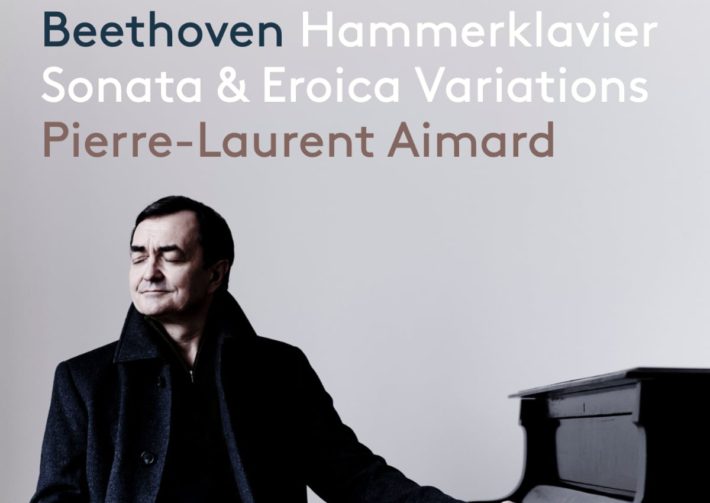In taking on Beethoven’s Hammerklavier and the Eroica Variations, even as a seasoned performer as Pierre Laurent Aimard admits that they pose an “insurmountable challenge.” At the same time, however, he says that this seeming impossibility is what makes them so alluring. For the audience, the listening experience is one and the same–we are eager to hear how he tackles works of such magnitude.
The iconic opening movement of the Hammerklavier is just as much about balance as it is contrast. Aimard’s tone is pleasantly round and emphasizes the piece’s orchestral nature. At the opposite end of the spectrum, this mellowness lends the softer sections a delicacy akin to, say, a flute or clarinet. The appropriately brisk tempo lets him effectively combine shorter phrases into longer units, which is crucial to a work of this expanse. A good example is the beginning, where the second set of chords builds upon the first in tension and intensity. Aimard’s interpretation sets up an interesting comparison to Emil Gilels’ landmark DG version from the early 1980s. Gilels’ slower tempo and drier articulation invoke greater austerity; each phrase, no matter how short, also assumes a distinct role. These differences make each version an interesting side to the same coin. (The one thing that Gilels has slightly better control over, however, are the accents–his tempo stays consistent going into them which heightens the element of surprise, where Aimard has a perceptible lurch forward beforehand).
The slow movements of Beethovn’s large sonatas are as notoriously difficult as the faster ones–not for the virtuosity of course, but for the minute technicalities and high degree of musicianship required. The Adagio Sostenuto (track 3) is no exception. The opening passage sees some excellent footwork from Aimard, whose overlapping pedalings simultaneously give the chords resonance and lateral smoothness. For all the beautiful sound quality, however, what’s missing for me is that hard-t0-grasp profundity. This interpretation is on the extroverted side: it could perhaps explore more dynamic gradations or take its time to let us savor some astounding harmonic changes (i.e. at 1:15). Christoph Eschenbach’s version from his EMI session in 1976 captures these elements superbly. It’s a good 9 minutes longer but certainly doesn’t feel that way. His interpretation is near-transcendent in that the sorrow and eventual catharsis have a powerful grip despite being barely above a whisper.
Related Classical Music Reviews
- Review: “Reimagine: Beethoven and Ravel” – Inna Faliks, Piano
- Review: “Mozart Momentum 1785” – Piano Concertos – Leif Ove Andsnes, Mahler Chamber Orchestra
- Review: Four Recent Chopin Albums (2021)
Aimard delivers the Eroica Variations with decided optimism–a good choice, given the emotional heft of the Hammerklavier. Experimenting with form and pushing the envelope with complexity (as always), Beethoven almost fools us into believing that the first-appearing bassline is the only theme. The joke is on us when we realize that the actual theme wafts in later (track 5, 2:46). Aimard does a nice job giving ample attention and distinct personas to each “theme,” with the bassline playing an assertive character and the second theme a more joyous one. For instance, the sprightly clarity in the latter parts of the Introduzione and the lighthearted swing of the waltz in Variation I (track 6) add a welcome sense of fun.
We cannot go without mentioning the large Fugue at the heart of the finale (track 21), which the pianist performs with precision. The iterations of the subject (based upon the original bassline) could have come out a bit more, but the sixteenth note runs are excellent. Consistent and crisp even as they cross voices, this texture provides a clear motivic thread that we can follow. The reappearance of the second theme at 2:17 offers a lovely respite from the unbounding energy of the previous sections, while the final moments have a carefree spontaneity.
The sound engineering is honest and brings out all aspects of the recording like the performer’s occasional humming and breathing. While some might find this distracting, I actually appreciated that they weren’t edited out. They are a natural part of the performance and proof of the musician’s effort and involvement. The wonderfully velvety tones of the piano are also front and center throughout. The liner notes, comprehensive and informative, are well worth the read.
Despite a few small issues, Aimard clearly shows that his musicianship–and confidence–hold up to the robustness of these two works. Warmly recommended.

Beethoven – Piano Sonata No. 29, Op. 106 (“Hammerklavier”), Eroica Variations, Op. 35
Pierre-Laurent Aimard – Piano
Pentatone, CD PTC 5186 724
Read more classical music reviews or visit The Classic Review Amazon store
Follow Us and Comment:
Get our periodic classical music newsletter with our recent reviews, news and beginners guides.
We respect your privacy.









